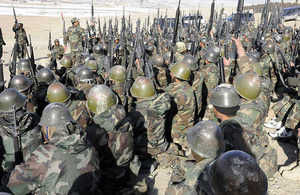Training Afghanistan's 'greatest generation'
The head of the NATO Training Mission (NTM) in Kabul spoke yesterday about the achievements made so far in building up effective Afghan National Security Forces and what improvements needed to be made next. Report by Ian Carr.

Afghan National Army trainees raise their weapons in acknowledgment of their Afghan trainer during a basic training lesson at the Kabul Military Training Centre [Picture: Staff Sergeant Sarah Brown, USAF]
US Lieutenant General William Caldwell began the briefing to the British media yesterday by highlighting the resourcefulness of British personnel in Afghanistan, saying:
I’ve been asked by my British colleagues if I would start by asking you all to pass on to their wives and girlfriends their best wishes for Valentine’s Day. For those who haven’t been able to arrange a card or the delivery of flowers, they reckon it will get them off the hook if you do.
The briefing, hosted by the MOD’s senior spokesman on Afghanistan, Major General John Lorimer, was delivered via a video link to Kabul by Lieutenant General Caldwell and by General Sher Mohammad Karimi, Chief of the General Staff of the Afghan National Army (ANA).
The briefing had two themes: firstly, the achievements made so far in building up effective national security forces, particularly in the last 15 months, and, secondly, to talk about what improvements needed to be made next.

A United States Army mentor mirrors an Afghan National Army trainee for technique corrections during a field training exercise at the Kabul Military Training Centre [Picture: Staff Sergeant Larry E Reid Jr, USAF]
General Karimi began by saying that although for nine years after the ANA was formed:
We had to struggle to build the Army, with the help of our coalition partners, we now have 134,000 in the Army. Our target is to increase that to 171,600 by October this year.
Meeting recruitment targets has not been a problem before, so I am confident that we will achieve that target by October, if not sooner.
But, in getting the numbers right, the drive to improve quality that has made such a difference over the last 14 months could not be compromised:
One of the greatest successes has been our programme of literacy training,” said Lieutenant General Caldwell. “Literacy is a game-changer and incredibly powerful enabler. It is becoming a matter of opportunity and hope.
Recently-released figures show that, since November 2009, 61,000 recruits have graduated from the NTM, with a literacy programme that boasts more than 85 per cent of students achieving first grade level or higher. Currently there are as many as 58,000 in training, and the intent is to increase this to 100,000 by the autumn.
Improvements such as these help improve manpower figures by attracting new recruits and reducing the numbers who leave. Now, 74 per cent of those completing their two-year contracts sign up for further service.
From 2003 to November 2009, when the NTM was created, Afghan soldiers were ill-equipped, illiterate, and unable to operate without significant coalition assistance. Because of this, and because the quality of Afghan Army leadership was poor, the numbers of soldiers leaving were high. So high in fact that, in September 2009, the Army strength actually declined by 1,200.
Since then, thanks to massive investment in development, the ANA has had a number of recruitment surges, with 2010 being the year of largest growth:
This was the untold story last year as the Afghan surge outpaced NATO’s,” said Lieutenant General Caldwell. “While the US surged by 30,000 troops, the Afghan Army and Police surged by 79,000. This was a 59 per cent increase in the Army alone, so it truly shows what is possible.
Over the last 15 months US$7.7bn has been invested in equipment and a further US$4.9bn will be forthcoming. Over the next year the focus will be on five streams of activity:
-
training the Afghan trainers
-
leadership development
-
improved literacy
-
stewardship, instilling troops with the sense of accountability for the equipment they have been given, and the importance of looking after it
-
developing sustainable systems and enduring institutions that will lead to Afghan National Security Forces capable of recruiting, training, equipping, fielding and sustaining themselves.
Of these, leadership was the one to which General Karimi drew particular attention:
Training the leaders is the most important question to me. Good leaders care for and develop the troops. They convince their soldiers of the need to stay and explain what we are trying to achieve.
We have built up an Army and trained them while also fighting. Good leaders help soldiers deal with battle fatigue and explain what will happen in the future; why they are having to live in tents until proper barracks can be built.
Lieutenant General Caldwell finished by saying that the Afghan National Army is one of the most respected organisations in Afghanistan, and one which had enormous influence on its people:
We can make a huge impact on Afghanistan by continuing to make great strides to build a professional force that can serve and protect the people of Afghanistan.
To do this, we must invest in the country’s human capital through literacy training and vocational skills training, helping to build Afghan business capital through our Afghan First initiative and supporting the development of the Army.
Our goal at NTM-A [NTM - Afghanistan] is to support the creation of Afghan leaders today and tomorrow; the men and women who will eventually become the next generation of community leaders for Afghanistan… their greatest generation.